Last Meeting
After Pope Benedict XVI met today with the Prime Minister of Canada — the Pope’s last private audience before his summer vacation — I was able to meet with the Pope for a few moments
By Robert Moynihan, reporting from Rome
Meeting with Stephen Harper
 A day after US President Barack Obama met with Pope Benedict XVI in the Vatican, the Pope received the Prime Minister of Canada, Stephen Harper, and his family: his wife Laureen, and his two children, Benjamin and Rachel.
A day after US President Barack Obama met with Pope Benedict XVI in the Vatican, the Pope received the Prime Minister of Canada, Stephen Harper, and his family: his wife Laureen, and his two children, Benjamin and Rachel.
Harper, coming off the Group of Eight world economic summit in nearby Aquila, Italy, was the fifth national leader to meet the Pope, following leaders of the United States, Japan, Korea and Australia.
“Why don’t you put you name in for one of the press pools?” Suor Giovanna (Sister Giovanna) said to me a few days ago.
Over the years, I have had my run-ins with Suor Giovanna. She is a severe, no-nonsense nun from Trent in northern Italy.
The Trentino is a region where the Alps start to climb toward Austria, and there the influence of “Germanic discipline” is felt more strongly than in the warm Italian south.
Since 1984 — about the time of my own arrival in Rome — Suor Giovanna has run the Vatican Press Office press credential section with an absolutely iron hand, occasionally striking fear into the heart of journalists who misplace or lose their Vatican press passes (Suor Giovanna: “I’m sorry, but you cannot get a replacement without reporting the loss to the Italian authorities…” Journalist: “Are you sure you can’t make an exception?” Suor Giovanna: “I’m sorry, no exceptions.”).
But in recent years, she has grown less gruff, and this past week — the week of her retirement — she has been positively cordial (I knew she always was, of course, deep down…). Indeed, she even broke down briefly in tears last week at her retirement press conference.
“Aren’t there many other journalists in line in front of me?” I asked.
“For President Obama, yes,” she said. “But ask Cindy what she can do for one of the other leaders…”
She was referring to Cindy Wooden, the veteran Catholic News Service Vatican reporter. Cindy is in charge of assigning journalists to the “pool,” or small group which goes into private meetings and reports back what they have seen and heard.
A couple of days later, Cindy said to me, “All right. You can go in the pool for the last visit, Prime Minister Stephen Harper of Canada. So you’ll get to meet the Pope, after the Prime Minister leaves. The Pope will receive the two journalists of the ‘pool’ and several from the Canadian press. You’ll have just a few seconds, unless he wishes to talk with you a bit longer…”
“Thanks!” I said.
“But listen,” she said. “We have a lot of clients in Canada. I’m relying on you to give us every detail. I want you to look at your watch at the start of the audience, and at the end of the audience, and tell me how many minutes it lasted. And what the Prime Minister’s wife is wearing. And what the gifts are. That’s important. And any words you hear at the start of the meeting. The cameras will be clicking, so it may be difficult to hear, but try. They usually speak a sentence or two. Sometimes you can catch a phrase…”
“I’ll take good notes,” I promised. “What time should I be here?”
“The audience will be at 11 a.m. Sister Giovanna will escort you up a few minutes before. You should be here at 10:15.”
I paused.
“Who will be going in with me?” I asked.
“Isabelle de Gaulmyn, Rome correspondent of the French daily La Croix.”
When writing about the Obama visit yesterday, I tried to develop an argument about “true and false science” and cloning, and I used a quote from Brave New World, and read through the little green book the Pope gave to Obama (I pulled up the text on the internet).
My newsflash was my attempt to explain the meaning of the Obama visit, and it took time, until long after midnight.
And as the time passed, and it became 2 a.m., then 3 a.m., I started to worry. “I’m going to be so tired tomorrow morning, I won’t have my wits about me when I meet the Pope.”
So that is the reason Newsflash #18 wasn’t even longer! I had to wrap it up and get to sleep, knowing I was going to have to take good notes for Cindy, and speak a few words to the Pope, in just a few hours….
The sky over the Piazza San Pietro this morning was as beautiful as I have ever seen it. The color was a cobalt blue, so clear and bright that it seemed to snap against the eyes like a like a splash of cold water. The Pope’s palace seemed almost orange in color, as if it was washed by the July morning light.
Rome can be like that, once every few years…
We went up from the Press Office on via delle Conciliazione — Suor Giovanna, Isabelle, and I.
“Can you be sure to take notes on the dress the Prime Minister’s wife is wearing?” I said to Isabelle.
Isabelle (photo) was sad. After four years in Rome as the Vatican correspondent for La Croix, the leading Catholic paper of France, she has been promoted to chief religion editor.
But this means she has to go back to Paris. And her two children don’t want to leave their school chums in Italy.
We went up through the Bronze Doors, up the wide marble stairway leading to the Cortile San Damaso, and across the Cortile to the same door President Obama entered yesterday.
We went up the same elevator to the seconda loggia, then down the long corridor to the Sala Clementina, and through that to Sala di Sant’Ambrogio, where we waited.
There we met up with a small group of Canadian journalists traveling with the Prime Minister.
Archbishop James Harvey came striding across the room, nodded to me, and set himself up at the entrance to the Sala Clementina to await the Prime Minister.
A few minutes later, the Prime Minister and his party arrived,
Preceded by a group of gentlemen of the Pontifical Household, they started to walk past us as cameras clicked.
The Prime Minister was walking tall and erect, taller even than Harvey, who is a tall man.
The Prime Minister’s wife — what was she wearing?
I fumbled for my pen. She was a pretty woman, slim, aristocratic, wearing a black jacket… Wait… Was it a jacket or a dress? Black shoes, black stockings, a black veil. I tried to make out the pattern in the veil. The cloth had sections which were transparent and sections which were solid black… I scribbled furiously. And then the group was past us and around the corner.
“Isabelle,” I said. “I don’t understand. Did the children not come?”
“Sure they came,” Isabelle said. “A boy and a little girl. They were right behind their mother. Didn’t you see them?”
Suor Giovanna ushered us down a very narrow hallway with a low roof, just a few inches above my head, and we came out in the antecamera next to the Pope’s library.
“They will come around the outside of the palace, then the Pope will greet them and the audience with the Prime Minister will begin,” Suor Giovanna told me. “The Pope seems to be a couple of minutes late.” She paused and smiled. “Perhaps he is on an important phone call…” Her eyes positively twinkled.
A new Suor Giovanna!
For about 20 minutes, it seemed, we waited in the antecamera. We were like caged animals kept in check, ready to pounce. Here is a picture of Suor Giovanna from that time:
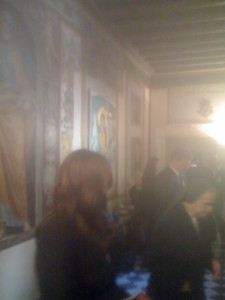
Then, suddenly, the doors opened. It was time.
The cameramen rushed in first. I was the last one through the door.
Prime Minister Harper was already seated, and the eight or ten cameras were clicking away, and I couldn’t hear a word he was saying.
Yesterday, Obama was seated directly across the table from the Pope.
Today, Harper was seated on the side of the table.
He looked a little bit stiff to me, as the cameras whirred like a nest of disturbed hornets, and he was evidently saying something, but I could not make out what it was though I strained to hear.
And then we were ushered back out of the room.
“Isabelle,” I said. “”Did you catch what they said?”
“They talked about the G8 meeting,” Isabelle told me. “The Pope asked how things went at the G8 summit, and the Prime Minister said, ‘Tres bien, tres bien.'” I noted that.
I also noted the time: 11:15. And exactly 21 minutes later, at 11:36, the doors to the library opened again. Back inside we went.
The Pope was at the far end of the room, and a long stream of people were on their way to greet him: first Laureen, who looked very dignified; then the boy, Benjamin (11 years old, one of the Canadians told me), walking quite tall and a bit stiffly; then Rachel (“7 or 8,” one of the Canadians said), looking a bit bashful, wearing white shoes and without a head covering over her blonde hair. And then the rest of the entourage…
So in all there were:
1) The Prime Minister, Stephen Harper
2) His wife, Laureen
3) His son, Benjamin, 11
4) His daughter, Rachel, “7 or 8”
5) Tony Clement, Canada’s Minister of Industry
6) Consiglio di Nino, a Senator
7) Dean Del Mastro
8) Paul Calandra
9) Guy Giorno, Chief of Staff
10) Anne Leahy, Ambassador to the Holy See
11) Dmitri Soudas, the Prime Minister’s press spokesman
Jim Prentice, Canada’s Minister of Development, was not present, though he was on the list of those who planned to attend.
I could see the gifts on the table right next to me: a vase, and a pen.
“The vase is by Andrew Kuntz,” Isabelle whispered to me. “He’s a Canadian deisgner…”
“How do you know that?” I asked, surprised. She didn’t answer, and hurriedly continued: “The pen is designed to look like one of the columns in the colonnade…”
The Prime Minister couldn’t seem to get the pen out of the case. After a moment, the Pope reached in and with a quick, powerful twist, lifted the pen out.
“What color is that vase?” I whispered to Isabelle. “Would you call that yellow? And what are those lines?”
“No, rose-colored,” she said. “And that’s an abstract gold-leaf motif…”
The Pope gave gifts to each of the 11 people, rosaries to the three women — Laureen, Rachel and Ambassador Leahy — and papal medals to the men.
When Rachel had difficulty opening her rosary, the Pope stepped forward and opened it for her, and patted her head in a grandfatherly way. That was the most touching moment of the visit.
At that point, Laureen said, in English, in words I heard quite clearly, “Thank you very much.”
There was no gift of the Pope’s recent encyclical, or of any other book on bioethics (like the book given to Obama), to the Prime Minister.
And then the meeting was over, the Pope escorted the Prime Minister to the door, and it was time for the Pope to greet us, one by one…
==============================
Here is how one news agency reported the audience: https://www.google.com/hostednews/canadianpress/article/ALeqM5j9ZoYsTUS8kzDmXjotnv6uTNzjOw
“The Pope opened their meeting with a brief French language exchange on the G8 summit — for the cameras — then conversed privately for 20 minutes.
“Afterwards, they were joined by Laureen Harper and the Harper children, Ben and Rachel, for an exchange of gifts.
“Harper presented a pink glass vase with an abstract gold leaf motif created by glassblower Andrew Kuntz at Toronto’s Sheridan College. In return, the prime minister received a glass mosaic fountain pen crafted at a Vatican workshop. The pen is a reproduction of one of the four pillars of St. Peter’s Basilica.
“The meeting took place in the library of the Apostolical palace, where the pontiff and the Vatican’s secretary of state work and live.
“Harper also met with Tarcisio Cardinal Bertone, then toured the basilica.
“The visit comes a week after the prime minister accepted communion at a Catholic service — though Harper is a practising evangelical Protestant — causing controversy in some circles.
“The Prime Minister’s Office did not hold a briefing with reporters after the meeting, but did issue a terse readout and a news release.
“‘It was an honour to meet Pope Benedict and hear his perspective on a number of important issues, including human rights and an ethical response to the global economic crisis,’ Harper said in the release. ‘I expressed my deep appreciation for the Holy Father’s moral and humanitarian leadership as an advocate of human dignity, peace and religious liberty, and for the spiritual leadership he provides to Catholics in Canada and throughout the world.’
“The readout said Harper and the Pope discussed human rights, religious freedoms and ‘a range of international issues,’ including Africa and climate change.”
Here is how the National Post reported the same meeting (https://www.nationalpost.com/news/story.html?id=1782386):
ROME — Prime Minister Stephen Harper, whose political breakthrough in 2006 has been linked to his success in winning over traditionally Liberal-voting Catholics, met Saturday with Pope Benedict XVI.
“It was an honour to meet Pope Benedict and hear his perspective on a number of important issues, including human rights and an ethical response to the global economic crisis,” Harper said in a prepared statement issued after the meeting.
“I expressed my deep appreciation for the Holy Father’s moral and humanitarian leadership as an advocate of human dignity, peace and religious liberty, and for the spiritual leadership he provides to Catholics in Canada and throughout the world.”
There was no indication the two discussed the controversy earlier this week when it was alleged that Harper, an evangelical Protestant, took – but did not consume – the Holy Communion host during the funeral of former governor-general Romeo LeBlanc.
Harper said he did consume it, despite a YouTube video that apparently shows him not putting the host in his mouth right away.
There was also no indication of whether they discussed the Church’s strong opposition to abortion and gay marriage. The Harper government has taken no steps to limit access to abortion in Canada, or ban gay marriage, even though a large number of his MPs oppose both.
The two men exchanged greetings at the Vatican during the brief period when cameras were allowed in the room, with the Holy Father asking Harper how the G8 summit went in the central Italian town of L’Aquila.
Harper replied that the three-day meeting of industrialized nations, which ended Friday and included modest progress in areas such as world hunger and climate change, went well.
The two men then went to a private room for a half-hour meeting before Harper’s wife, Laureen, and children Ben and Rachel, met the Pope.
The Pope gave Harper an artistic pen, manufactured by the Vatican Museum and based on a design of one of the four pillars of the main altar of the Basilica. Harper gave the Pope a pink vase.
Harper then met with Cardinal Tarcisio Bertone, the Vatican’s Secretary of State, for a discussion that included “human rights and religious freedoms,” according to Harper’s office. The Harpers then toured St. Peter’s Basilica.
Harper, who has a Presbyterian background, is a member of the East Gate Christian and Missionary Alliance congregation in Ottawa.
His election victory in 2006 has been linked partly to his strong showing among evangelical Protestants and church-going Catholics.
Historically, a clear majority of Catholic Canadians – estimated by Statistics Canada at roughly 13 million – have voted Liberal, according to research by University of Montreal political scientist Andre Blais.
However, former Liberal prime ministers Paul Martin and Jean Chretien, both Catholics, were heavily criticized by Canadian bishops for their support of gay marriage.
Former New Democrat MP Dennis Gruending, one-time director of information for the Canadian Conference of Catholic Bishops, has credited Harper’s gains among Catholics as a key element of his political success.
“The vote of evangelical Christians and Catholics who attend church weekly was a deciding factor” in the 2006 election that led to a minority Tory government, Gruending wrote in his Pulpit & Politics blog.
Deborah Gyapong, a journalist who specializes on issues relating to faith and politics, agreed Saturday that church-going Catholics were critical to Harper’s 2006 breakthrough.
She said Harper’s visit Saturday will please many of Canada’s estimated 13 million Catholics.
“Recognizing the moral authority of the Pope is going to be very significant to Canadian Catholics, it shows the regard and the stature of the Holy Father,” said Gyapong, who covered the meeting for the Canadian Catholic News.
“Even for Evangelical Protestants like Harper, there is no other Christian leader who has anywhere near his intellectual and theological gravitas of Pope Benedict XVI.”
It’s funny, I thought, reading these reports, how much can be written about a meeting though only the first four words of the conversation were able to be heard…
At the very end, I walked up to Pope Benedict, who was dressed in white as in the photo at the top of this newsflash. We spoke in Italian.
“Oh, Dr. Moynihan,” he said. I took his hand in mine. “How is the magazine, Inside the Vatican? Is it going well?”
“Very well,” I said. “Thank you.”
“And your children? They must be so tall now…”
“Yes,” I said. “The younger one, Luke, is my height, and the older one, Christopher, is 20 now, and much taller than I am.” I lifted my hand up above my head to indicate his height. “He is in St. Petersburg for the summer, studying the Russian language, and also the piano.”
“Oh really,” the Pope said. “That must be very interesting for him. My best wishes…”
“I wanted to wish you a happy onomastico (name day),” I said. “It’s the Feast of St. Benedict.”
The Pope smiled. “Yes it is. Thank you very much. God bless you and your work.”
Sister Giovanna led us out and I managed to take a couple of photos as we went out of the Apostolic Palace. As I did, I started to fall a bit behind Isabelle and Sister Giovanna, and suddenly there was an entire cohort of Swiss Guards on the stairs behind me. I hurried after Sister Giovanna.
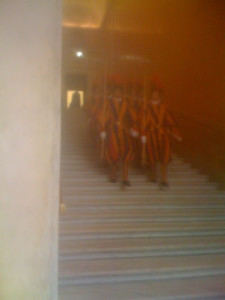 Speaking of photographs, in my haste last night, I left out a photo credit for a very nice photo of President Obama (below), which I will publish again here with full credit.
Speaking of photographs, in my haste last night, I left out a photo credit for a very nice photo of President Obama (below), which I will publish again here with full credit.
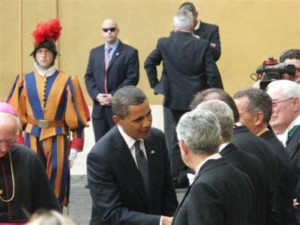
It is the work of American journalist Joan Lewis, the EWTN correspondent in Rome, who also writes her own very informative and accurate blog on Vatican events (just Google Joan Lewis blog).
I have learned a great deal from Joan. She works around the clock, setting a hard pace to keep up with! And now that she is starting to take her own photographs, she may soon be one of the leading sources of Vatican images as well as of Vatican news.
Actually, Joan is partly responsible for my becoming a Vaticanist. She was the correspondent in Rome for the National Catholic Register in the mid-1980s, and when she left for a time to go back to her native California, Fran Maier, the editor at the time, hired me to write two articles each month, as her replacement. Had that not happened, I might very well have left Rome in 1986.
Here is a picture I took of Joan yesterday, July 10, using her camera, just moments after President Obama went into the Vatican to meet with the Pope:
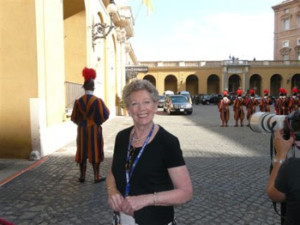
The Pope leaves on Monday, July 13, for his two-week summer vacation in northern Italy.
He will then come back to Rome at the end of July, but not to the Vatican. Instead, he will be staying out at Castel Gandolfo, about 30 miles outside the city, where it is much cooler.
Just as I was preparing to file this report, I received in my email a file from Sandro Magister, another veteran Vatican journalist. An Italian, Magister has been as much “on top” of the big stories in the Vatican for the past few years as anyone.
This story, which I enclose below, is a controversial and fascinating one, and especially important for those are committed in a special way to the pro-life movement, as the story involves the President of the Pontifical Academy for Life, Archbishop Rino Fisichella, an Italian.
It is also in many ways quite a sad story, with complexities and problems that make it complicated both emotionally and intellectually. I would like to reflect on it at greater length at some future time, but not tonight.
The following is from Sandro Magister’s blog: https://chiesa.espresso.repubblica.it/?eng=y
The Fisichella Case
Retractions. The Holy Office teaches Archbishop Fisichella a lesson. The Congregation for the Doctrine of the Faith has released a “clarification” that in fact repudiates the article published in L’Osservatore Romano by the president of the pontifical academy for life, on the abortion performed on a Brazilian mother-child. Here’s the document
by Sandro Magister
ROME, July 10, 2009 – This afternoon, at the very same time as Benedict XVI was meeting at the Vatican with the United States president Barack Obama, L’Osservatore Romano printed a “clarification” by the Congregation for the Doctrine of the Faith, “on procured abortion.”
The “clarification” is what many were waiting for after a controversial article published last March 15 by the same newspaper of the Holy See, signed by Archbishop Rino Fisichella, president of the Pontifical Academy for Life.
The “clarification” is printed on page 7 of the newspaper of the Holy See, and is announced on the front page.
Fisichella’s article concerned the case of an extremely young Brazilian mother-child who was made to abort the twins she was carrying in her womb, and was interpreted by many as justifying the double abortion.
There followed a lively public controversy, which www.chiesa related in two extensive articles. But at the same time, the Vatican authorities received many protests and requests through private channels.
These included the step taken by 27 of the 46 members of the pontifical academy for life. On April 4, they wrote a joint letter to Fisichella, their president, asking him to correct the “mistaken” positions he had expressed in the article.
On April 21, Fisichella responded to them in writing, rejecting the request.
On May 1, 21 of the signers of the previous letter then went to Cardinal William Levada, prefect of the congregation for the doctrine of the faith, asking the congregation for a clarifying statement on the Church’s teaching on the matter of abortion.
The letter was delivered on May 4, but did not receive any reply. The writers learned from an official at the congregation that the letter had been forwarded to the secretary of state, Cardinal Tarcisio Bertone, “because Fisichella’s article had been written at his request.”
Two members of the pontifical academy for life then sent a dossier on the matter directly to the pope.
On June 8, Benedict XVI discussed the case with Bertone, and ordered that a statement be published reconfirming that the Church’s teaching on abortion is unchanged.
The “clarification” published today in “L’Osservatore Romano,” dated July 11, 2009, is precisely the fruit of this decision.
Here it is in its original form:
On procured abortion
Clarification from the Congregation for the Doctrine of the Faith
Recently a number of letters have been sent to the Holy See, some of them from prominent figures in political and ecclesial life, explaining the confusion that has been created in various countries, especially in Latin America, following the manipulation and exploitation of an article by His Excellency Archbishop Rino Fisichella, president of the Pontifical Academy for Life, on the sad affair of the “Brazilian girl.”
In this article, which appeared in “L’Osservatore Romano” on March 15, 2009, the doctrine of the Church was presented, while still keeping in mind the dramatic situation of the aforementioned girl, who – as could be demonstrated afterward – had been accompanied with all pastoral delicacy, in particular by the archbishop of Olinda and Recife at the time, His Excellency Archbishop José Cardoso Sobrinho.
In this regard, the Congregation for the Doctrine of the Faith reiterates that the Church’s teaching on procured abortion has not changed, nor can it change.
This teaching has been presented in numbers 2270-2273 in the Catechism of the Catholic Church, in these terms:
«Human life must be respected and protected absolutely from the moment of conception. From the first moment of his existence, a human being must be recognized as having the rights of a person – among which is the inviolable right of every innocent being to life “Before I formed you in the womb I knew you, and before you were born I consecrated you” (Jer. 1:5). “My frame was not hidden from you, when I was being made in secret, intricately wrought in the depths of the earth” (Psalm 139:15).
«Since the first century the Church has affirmed the moral evil of every procured abortion.
This teaching has not changed and remains unchangeable. Direct abortion, that is to say, abortion willed either as an end or a means, is gravely contrary to the moral law: “You shall not kill the embryo by abortion and shall not cause the newborn to perish” (Didaché, 2:2). “God, the Lord of life, has entrusted to men the noble mission of safeguarding life, and men must carry it out in a manner worthy of themselves. Life must be protected with the utmost care from the moment of conception: abortion and infanticide are abominable crimes” (Vatican Council II, “Gaudium et Spes”, 51).
«Formal cooperation in an abortion constitutes a grave offense. The Church attaches the canonical penalty of excommunication to this crime against human life. “A person who procures a completed abortion incurs excommunication latae sententiae,” (Code of Canon Law, can. 1398), “by the very commission of the offense” (Code of Canon Law, can. 1314) and subject to the conditions provided by Canon Law (cf. Code of Canon Law, can. 1323-1324). The Church does not thereby intend to restrict the scope of mercy. Rather, she makes clear the gravity of the crime committed, the irreparable harm done to the innocent who is put to death, as well as to the parents and the whole of society.
«The inalienable right to life of every innocent human individual is a constitutive element of a civil society and its legislation: “The inalienable rights of the person must be recognized and respected by civil society and the political authority. These human rights depend neither on single individuals nor on parents; nor do they represent a concession made by society and the state; they belong to human nature and are inherent in the person by virtue of the creative act from which the person took his origin. Among such fundamental rights one should mention in this regard every human being’s right to life and physical integrity from the moment of conception until death… The moment a positive law deprives a category of human beings of the protection which civil legislation ought to accord them, the state is denying the equality of all before the law. When the state does not place its power at the service of the rights of each citizen, and in particular of the more vulnerable, the very foundations of a state based on law are undermined… As a consequence of the respect and protection which must be ensured for the unborn child from the moment of conception, the law must provide appropriate penal sanctions for every deliberate violation of the child’s rights.” (Congregation for the Doctrine of the Faith, Instruction “Donum Vitae”, III)».
In the encyclical “Evangelium Vitae,” Pope John Paul II reaffirmed this teaching with his authority as Supreme Pastor of the Church:
«By the authority which Christ conferred upon Peter and his Successors, in communion with the Bishops-who on various occasions have condemned abortion and who in the aforementioned consultation, albeit dispersed throughout the world, have shown unanimous agreement concerning this doctrine-I declare that direct abortion, that is, abortion willed as an end or as a means, always constitutes a grave moral disorder, since it is the deliberate killing of an innocent human being. This doctrine is based upon the natural law and upon the written Word of God, is transmitted by the Church’s Tradition and taught by the ordinary and universal Magisterium. No circumstance, no purpose, no law whatsoever can ever make licit an act which is intrinsically illicit, since it is contrary to the Law of God which is written in every human heart, knowable by reason itself, and proclaimed by the Church» (no. 62).
As for abortion procured in certain difficult and complex situations, the clear and precise teaching of Pope John Paul II applies:
«It is true that the decision to have an abortion is often tragic and painful for the mother, insofar as the decision to rid herself of the fruit of conception is not made for purely selfish reasons or out of convenience, but out of a desire to protect certain important values such as her own health or a decent standard of living for the other members of the family. Sometimes it is feared that the child to be born would live in such conditions that it would be better if the birth did not take place. Nevertheless, these reasons and others like them, however serious and tragic, can never justify the deliberate killing of an innocent human being» (Encyclical “Evangelium Vitae”, no. 58).
As for the problem of specific medical treatments intended to preserve the health of the mother, it is necessary to make a strong distinction between two different situations: on the one hand, a procedure that directly causes the death of the fetus, sometimes inappropriately called “therapeutic” abortion, which can never be licit in that it is the direct killing of an innocent human being; on the other hand, a procedure not abortive in itself that can have, as a collateral consequence, the death of the child:
«If, for example, saving the life of the future mother, independently of her condition of pregnancy, urgently required a surgical procedure or another therapeutic application, which would have as an accessory consequence, in no way desired or intended, but inevitable, the death of the fetus, such an action could not be called a direct attack on the innocent life. In these conditions, the operation can be considered licit, as can other similar medical procedures, always provided that a good of high value, like life, is at stake, and that it is not possible to postpone it until after the birth of the child, or to use any other effective remedy» (Pius XII, Speech to the Fronte della Famiglia and the Associazione Famiglie numerose, November 27, 1951).
As for the responsibility of medical workers, the words of Pope John Paul II must be recalled:
«Their profession calls for them to be guardians and servants of human life. In today’s cultural and social context, in which science and the practice of medicine risk losing sight of their inherent ethical dimension, health-care professionals can be strongly tempted at times to become manipulators of life, or even agents of death. In the face of this temptation their responsibility today is greatly increased. Its deepest inspiration and strongest support lie in the intrinsic and undeniable ethical dimension of the health-care profession, something already recognized by the ancient and still relevant Hippocratic Oath, which requires every doctor to commit himself to absolute respect for human life and its sacredness» (Encyclical Evangelium Vitae, no. 89).
Again, here is the link: https://chiesa.espresso.repubblica.it/articolo/1339277?eng=y

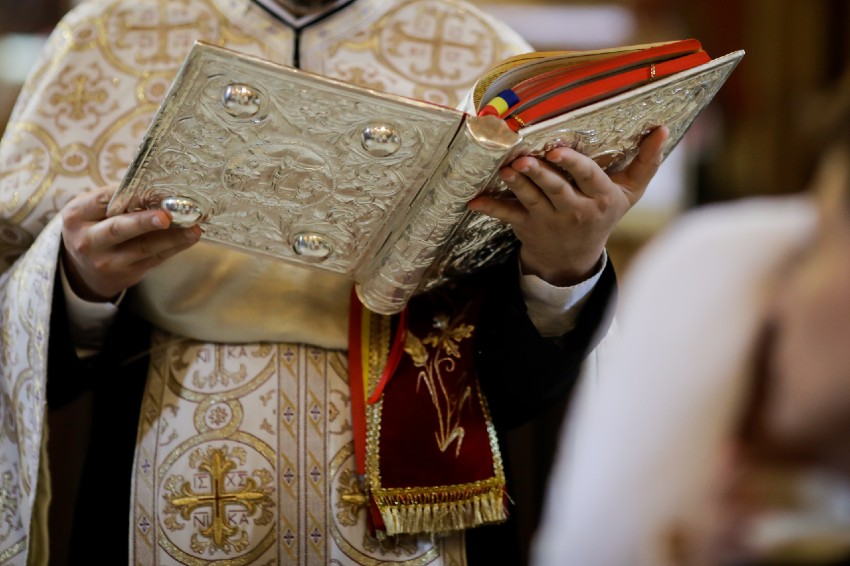
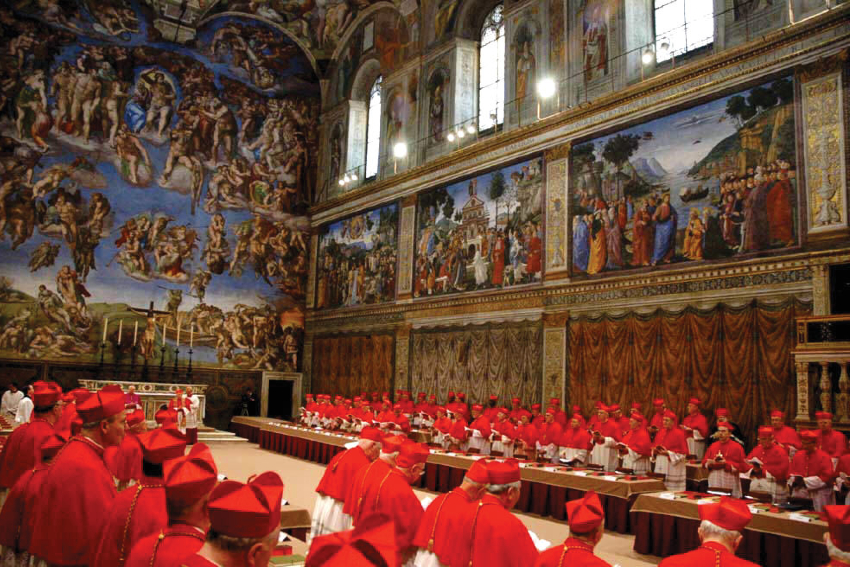



Facebook Comments